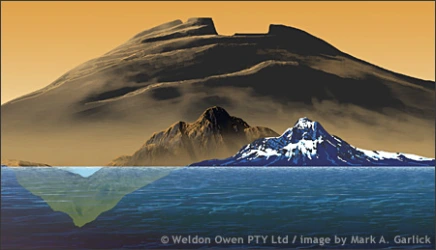I'm reading the Mars trilogy now, by Kim Stanley Robinson. The story starts with the first efforts to colonize Mars and then, through the passage of a couple hundred years and incredible advancements in terraforming, Mars becomes a planet with oceans, forests, and ecosystems.
The really interesting stuff involves the evolution of the people, their culture, society, and political philosophy; there is much here to think about.
But, putting aside the political and philosophical implications of the book for a moment, lets take a look at the geography. In the book there is a Santa Clause-like mythology built up around the immensity of the geological structures found on Mars; this is the Big Man's playground!
Here are my top three:
Olympus Mons
Latin for Mount Olympus, this is the largest mountain in the solar system at 22km high; 3 times the height of Mount Everest. Having a very gradual incline, if one were to stand near the summit of this ancient volcano the slope would extend right out to the horizon - it would not even appear you were on a mountain at all!
Valles Marineris
Stretching almost one quarter of the circumference of Mars, this system of canyons makes the Grand Canyon look like a small trench. Valles Marineris runs for 4000 km, is 200 km wide, and 7 km deep.
Hellas Basin
This is an impact basin formed when a large asteroid hit the planet some 4 billion years ago. The basin floor is 7 km from its rim, and the diameter is, unbelievably, 2300 km! This is the largest visible impact basin in the solar system.






No comments:
Post a Comment